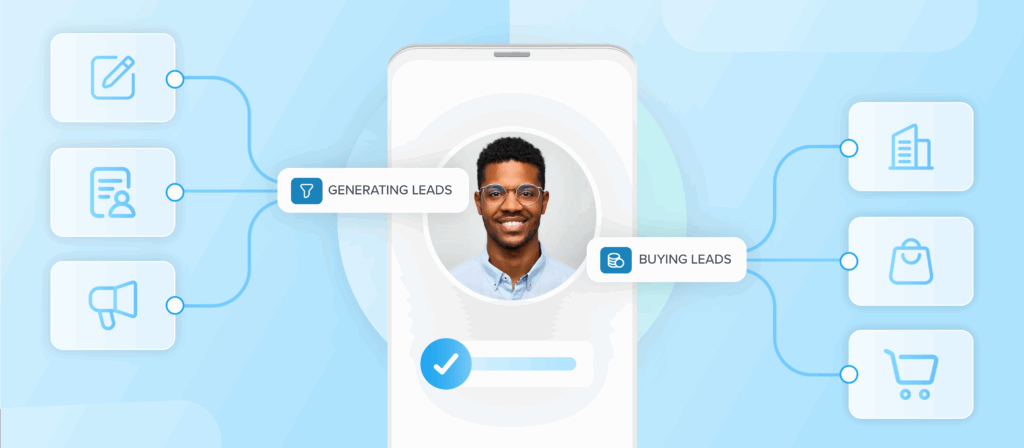Generate leads vs. buy leads: Which strategy works best?

In the world of performance marketing, every company faces the same fundamental challenge — how to keep a steady stream of high-quality leads flowing into the sales funnel. Some brands build their own lead generation systems in-house, while others choose to buy leads from reputable vendors. But when it comes to generate lead vs. buy lead, which approach delivers better results?
The answer depends on your goals, resources, and risk tolerance. In this guide, we’ll explore the key differences between generating and buying leads, weigh the pros and cons of each, and share best practices to help you get the most out of your lead acquisition strategy — whether you’re running your own campaigns or purchasing from third-party providers.
Generate lead vs. buy lead: What’s the difference?
At a high level, lead generation means building your own pipeline of prospects — attracting visitors through your own marketing channels (like content marketing, SEO, paid ads, or webinars) and converting them into leads. You own the entire process and all the resulting data.
Buying leads, on the other hand, involves purchasing contact information from a vendor who collects leads through their own campaigns or publisher network. You don’t own the acquisition funnel — but you can access pre-collected leads that meet your targeting criteria.
Here’s a quick breakdown:
| Approach | How it works | Ownership | Timeframe | Cost structure |
| Generating leads | You create and run your own campaigns to capture leads directly | Full control and data ownership | Slower to build momentum | Costs depend on ad spend and resources |
| Buying leads | You purchase leads collected by third-party vendors or marketplaces | Limited control over collection | Immediate access to prospects | Typically priced per lead (CPL model) |
Both paths can be profitable — but they carry different benefits and risks.
The pros and cons of buying leads vs. running your own campaigns
When it comes to buy leads vs. running your own campaigns, the decision often comes down to speed, scalability, and control. Let’s break it down.
Pros of buying leads
- Speed to market: Buying leads lets you start selling right away — no waiting for campaigns to mature. This can be crucial for startups or teams needing quick ROI.
- Scalability: If your vendor relationships are strong, you can scale up or down almost instantly depending on your sales capacity.
- Access to new audiences: Third-party publishers often reach audiences you can’t access organically. This expands your total addressable market.
- Predictable costs: Since most lead vendors sell on a cost-per-lead (CPL) basis, you can forecast your acquisition costs precisely.
Cons of buying leads
- Lower transparency: You might not know how or where the leads were collected, making it harder to ensure quality and compliance.
- Inconsistent quality: Not all leads are created equal — and without the right tools, filtering out low-quality submissions can be costly.
- Compliance risk: If the vendor fails to collect proper TCPA consent, you could face serious legal exposure when reaching out to those contacts.
- Less brand control: You don’t control the messaging or form experience that generated the lead, which can affect trust and conversion rates.
Pros of generating leads in-house
- Full data ownership and control: You own the journey from click to conversion — every interaction and data point belongs to you.
- Higher conversion rates: Leads that come through your own funnel are already familiar with your brand, making them more likely to engage and convert.
- Compliance confidence: Since you control the form, consent language, and collection process, compliance management is easier.
- Long-term ROI: Once your campaigns mature, in-house lead generation can become a predictable, self-sustaining growth engine.
Cons of generating leads in-house
- Time-intensive setup: Building an in-house lead gen system requires time, resources, and continuous optimization.
- Higher upfront costs: You’ll need creative assets, landing pages, tracking infrastructure, and ad budgets before you see results.
- Scaling challenges: Expanding campaigns without sacrificing lead quality requires expertise and constant management.
Buying leads vs. Facebook-generated leads
Facebook remains one of the most popular platforms for in-house lead generation, so it’s worth exploring buying leads vs. Facebook-generated leads.
Buying leads
Buying leads from third-party vendors gives you instant access to a large volume of prospects across multiple traffic sources (search, display, comparison sites, etc.). The advantage lies in diversity — you’re not dependent on one ad platform.
However, you’ll need to verify lead quality and consent independently. Without proper checks, you risk paying for fake or bot-generated leads.
Facebook-generated leads
When you generate leads on Facebook, you’re leveraging Meta’s powerful targeting and automation tools. You can precisely target audiences based on demographics, interests, and behaviors — and because leads come directly from your ads, you control the creative and consent process.
The tradeoff? Facebook leads require constant optimization to maintain performance. They may also be platform-dependent — meaning changes to Meta’s algorithm or ad policies can impact your lead flow.
The best approach often involves combining both — buying high-quality, consented leads while running Facebook campaigns to strengthen brand recognition and inbound lead flow.
How to make the most out of your lead buying
Buying leads can deliver outstanding ROI — but only if you’re equipped with the right tools and processes to manage, verify, and optimize your pipeline.
Here are two essential best practices to protect your investment and maximize results:
1. Use TrustedForm to document third-party consent
When you buy leads, compliance is everything. The Telephone Consumer Protection Act (TCPA) requires proof that every consumer consented to be contacted.
That’s where TrustedForm, part of the ActiveProspect platform, comes in. It provides an independent record of consent by documenting the exact moment a lead submitted their information — including:
- The URL where the lead form was filled out
- The date and time of submission
- A video-like session replay of the user’s form interaction
- The consent language shown at submission
This certificate can help protect your business from costly legal risks, including contacting leads who may not have consented to outreach, and offer data insights to help determine the lead came from a real person and not a bot.
Pro tip: Always request TrustedForm Certificates from your vendors. It’s the gold standard for TCPA compliance and transparency in lead buying.
2. Use LeadConduit to scrub and route leads in real time
Even when working with top-tier vendors, some leads may still be invalid, incomplete, or duplicated. LeadConduit, another ActiveProspect solution, helps automate quality control at the point of entry.
With LeadConduit, you can:
- Validate contact data (emails, phone numbers, addresses)
- Filter duplicates before they reach your CRM
- Scrub for compliance (e.g., remove contacts on DNC lists, RND lists, or TCPA litigators)
- Enrich leads with data from third party service providers
- Route leads intelligently to the right sales team or platform
The result: You only pay for valid, compliant, and actionable leads — improving ROI while saving hours of manual cleanup.
Pro tip: Combine TrustedForm and LeadConduit for a powerful, automated lead management workflow that protects your business and maximizes conversion potential.
3. Use LeadsBridge to sync, track, and optimize your ad platform lead flow
If you’re running paid campaigns alongside purchased leads, one of the biggest challenges is getting your lead data where it needs to be — instantly, accurately, and consistently. That’s where LeadsBridge, part of the ActiveProspect platform, becomes invaluable.
LeadsBridge is a no-code automation platform that connects your social media lead forms and advertising platforms—like Meta, Google, LinkedIn, and TikTok—directly to your CRM, dialer, email system, or LeadConduit. This allows you to streamline lead intake across channels and ensure your sales team acts on new leads the moment they arrive.
With LeadsBridge, you can:
- Sync leads from major ad platforms to your CRM in real time
- Reduce delays and improve speed-to-lead without manual CSV uploads
- Track online and offline conversions for more accurate attribution
- Build custom audiences based on your CRM data to improve campaign performance
- Automate workflows without relying on engineering resources
Whether you’re scaling paid social, testing new channels, or closing the loop between marketing and sales, LeadsBridge keeps your lead data flowing smoothly — making your entire acquisition strategy more efficient and predictable.
Pro tip: For maximum impact, use LeadsBridge to route ad-platform leads into LeadConduit, where they can be validated, enriched, and filtered before hitting your CRM.
Final thoughts
The generate lead vs. buy lead debate doesn’t have a one-size-fits-all answer. It’s about balance.
If you have the budget and infrastructure to build long-term assets, running your own lead generation campaigns provides control, compliance, and brand trust. But if you need immediate scale or want to test new markets quickly, buying leads from reputable vendors can be a fast, cost-effective growth lever — as long as you implement the right verification and routing tools.
Ultimately, the smartest marketers do both. They generate leads to build a sustainable inbound funnel and buy financial, insurance, or home services leads to accelerate short-term performance — all while using platforms like TrustedForm, LeadConduit, and LeadsBridge to ensure every lead is clean, compliant, and conversion-ready.
Ready to get more from your lead acquisition strategy? Book a demo with ActiveProspect and see how our solutions can help you optimize every lead you buy.



